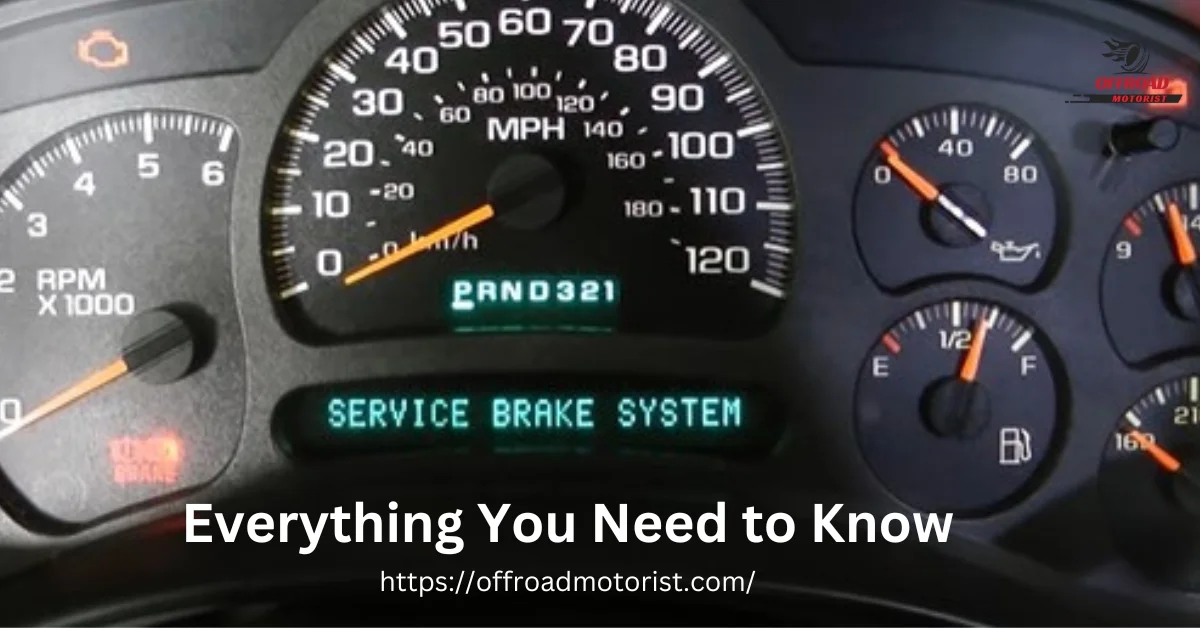Revitalize Your Chevy’s Power “Service Battery Charging System” [Problem Solved]
Showing “Service Battery Charging System” on your Chevy’s Dashboard? Are you tired of worrying about battery draining while you’re on the go? Want to ensure your vehicle’s power source is always up and running?
If so, it’s time to familiarize yourself with your Chevy’s “Service Battery Charging System” display. Explore the information you need to keep your vehicle’s battery in top condition and avoid unexpected breakdowns.
In this post, we’ll explore the Battery Charging System, how it works, and how you can use it to keep your Chevy charged and ready for adventure. So, buckle up and get ready to revitalize your Chevy’s power!
Understanding the “Service Battery Charging System”
The Battery Charging System is an important component of your Chevy’s electrical system. It monitors and maintains the charge level of your vehicle’s battery & ensures it has enough power to start the engine and run all the electrical systems.
The system uses a combination of sensors and regulators to monitor the battery’s voltage and amperage levels. If the battery charge falls below a certain level, the charging system will automatically kick in and recharge the battery.
A properly functioning battery charging system is essential for ensuring your Chevy has the power it needs to start and run smoothly. It will help you avoid the inconvenience and stress of a dead battery.
It can also extend the life of your battery and prevent more serious electrical problems down the road.
So, if you want to ensure that your Chevy is always running at its best, it’s important to understand how the Battery Charging System works and what you can do to keep it functioning optimally.
Doing so can give your vehicle the power it needs to take on any challenge and keep you on the road for years to come.
Signs of a Failing Battery Charging System
Regarding your Chevy’s battery charging system, it’s important to know the warning signs of a failing system. Recognizing these signs early can help you avoid the inconvenience and stress of a dead battery.
One of the most obvious signs of a failing battery charging system is showing a message “Service Battery Charging System” on your Chevy’s dashboard display screen. Take this warning message seriously and have your vehicle inspected as soon as possible.
Another indicator of a malfunctioning battery charging system is a battery that won’t hold a charge or is slow to start the engine.
If you notice that your vehicle is slow to start or that the battery drains quickly even when you’re not using it, it’s likely a sign that your battery charging system is not functioning properly.
You may experience other symptoms like dimming lights or electronics that shut off unexpectedly. These are signs that your vehicle’s battery is not getting the charge it needs to run all of the electrical systems properly.
It’s important to address these warning signs as soon as possible. A malfunctioning battery charging system can cause further damage to your vehicle’s battery and electrical system if left unaddressed.
Having your vehicle inspected and repaired by a professional mechanic ensures that your battery charging system is functioning properly and your vehicle has the power it needs to run smoothly.
Troubleshooting the “Service Battery Charging System”
If you suspect your Chevy’s Battery Charging System is not functioning properly, you can perform a few simple checks at home to help diagnose the problem.
01. Check the battery connections
Prepare yourself by wearing gloves & safety glasses. Follow these steps to diagnose the battery connections:
- Locate the battery in your vehicle (The exact location of the battery will vary depending on the make and model of the vehicle. It is best to consult the owner’s manual)
- Identify the positive (+) and negative (-) terminals
- Check for corrosion or debris on the terminals
- Check the tightness of the terminal connections
- Clean the terminals if necessary
- Tighten any loose connections
- Check the battery cables for any damage or corrosion.
Make sure that the battery connections are clean and tight. Loose connections can cause the battery not to charge properly.
02. Inspect the alternator belt
The alternator belt powers the battery charging system. The battery may not charge properly if the belt is loose, frayed, or broken. If the belt is too loose, it will cause the alternator and the battery to work harder.
Follow these steps to inspect the alternator belt:
- Locate the alternator: The alternator is typically located in the engine compartment, near the front of the engine.
- Identify the alternator belt: The alternator belt is a ribbed, serpentine belt that wraps around several pulleys, including the alternator.
- Check for visible damage: Look for cracks, fraying, or missing chunks of rubber on the belt.
- Check the tightness: Observe the alternator belt while the engine is running. The belt should be tight, but not too tight, and should not slip or squeal.
- Check for proper alignment: Ensure that the belt is properly aligned on the pulleys and not rubbing against any other parts.
- Check the tension: You can check the tension by pressing down on the belt with your thumb. The belt should be firm and not too loose.
If you find the alternator belt loose, frayed, or broken, take your vehicle to a professional mechanic. They will help you fix the alternator belt issue properly.
03. Check the battery voltage
Low voltage readings can indicate a weak battery, a bad alternator, or other issues with the charging system.
Here are the steps to check the battery voltage:
- Obtain a multimeter: A multimeter measures electrical voltage, current, and resistance. You can purchase a multimeter at an auto parts store or online.
- Turn off the vehicle: Ensure the vehicle is turned off and the key is removed from the ignition.
- Set the multimeter to measure DC voltage: Most multimeters have a dial or button that allows you to select the type of measurement you want to take. Set the multimeter to measure DC voltage.
- Touch the positive and negative probes to the battery terminals: Touch the red probe to the positive (+) battery terminal and the black probe to the negative (-) terminal.
- Read the voltage: The multimeter will display the voltage of the battery. A fully charged 12-volt battery should read between 12.5 and 12.8 volts.
- Repeat the test with the engine running: Start the engine and repeat the test. The voltage should increase with the engine running to 13.5 volts or higher.
If you find the battery voltage below recommended ratio, it is recommended to seek the assistance of a qualified mechanic to fix this issue properly.
04. Check the battery cable
The battery cable is responsible for transmitting power from the alternator to the battery.
Follow these steps to check the battery cables:
Locate the battery: The battery is typically located in the engine compartment, mounted on a tray or bracket.
Identify the positive (+) and negative (-) battery terminals: The positive terminal is usually marked with a “+” symbol and is red or has a red cover. The negative terminal is usually marked with a “-” symbol and is black or has a black cover.
Check for visible damage: Look for cracks, fraying, or missing insulation on the battery cables.
Check the tightness of the terminal connections: Make sure the battery cable clamps are tight on the battery terminals.
Check the battery cables for any corrosion: Corrosion on the battery cables can reduce the flow of electricity and cause starting and charging issues. Clean any corrosion that you find.
Check the battery cables for any damage: Look for any cuts, frays, or other damage to the battery cables.
It is recommended to seek the assistance of a qualified mechanic. A damaged battery cable can cause various issues, including decreased starting performance and reduced charging performance.
By troubleshooting your Service Battery Charging System, you can ensure that your Chevy has the power it needs to run smoothly and avoid any unexpected breakdowns.
Note: If simple checks don’t resolve the issue, take your vehicle to a professional for diagnosis and repair. They will identify the specific problem and make necessary repairs to restore the proper functioning of the Battery Charging System.
Maintenance Tips for Optimal Battery Charging System Performance
Maintaining your Chevy’s Service Battery Charging System is important for ensuring that it functions properly and provides your vehicle with the power it needs to run smoothly.
Here are some maintenance tips to keep your battery charging system performing at its best:
- Keep battery connections clean
Dirt and corrosion on the battery terminals can reduce the battery’s ability to hold a charge. Clean the terminals regularly with a wire brush and baking soda solution.
- Check and adjust the alternator belt tension
A loose alternator belt can reduce the battery’s ability to charge. Regularly inspect the belt and tighten it if necessary.
- Keep the battery clean
Dirt and debris on the battery can reduce its performance and shorten its lifespan. Clean the battery regularly with a damp cloth.
- Monitor battery voltage
Regularly check the battery voltage using a voltmeter. A healthy battery should have a voltage of between 12.5 volts to 12.5 volts. If the voltage is consistently lower, replace it or consult a professional mechanic.
- Avoid overcharging the battery
Overcharging the battery can damage and reduce its ability to hold a charge. Make sure to use a quality battery charger with an automatic shut-off when fully charged.
- Have your vehicle regularly inspected
Regular inspections can help identify potential problems with your Service Battery Charging System before they become more serious.
By following these simple maintenance tips, you can keep your Chevy’s Battery Charging System functioning optimally and ensure that your vehicle has the power it needs to run smoothly.
Experiencing issues with your car not starting? It could be related to a problem with the StabiliTrak system. Click here for details about “Service StabiliTrak,” & If your Car doesn’t Start, Try These Fixes!
FAQs
The Service Battery Charging System message in a GM vehicle is a warning indicating an issue with the battery charging system.
In this session, we’ll try answering some commonly asked questions to increase your knowledge about “Service Battery Charging System” Let’s get started.
Why is my service battery charging system on?
It is a warning message indicating an issue with the battery charging system, potentially caused by the alternator, battery, or other related components.
What should I do if I see the Service Battery Charging System message?
You should take your vehicle to a mechanic for diagnosis and repair if the message appears.
How to reset the service battery charging system light?
The Service Battery Charging System warning light can typically be reset by disconnecting the vehicle’s battery for a few minutes, then reconnecting it and starting the engine.
Will a reset fix the “service battery charging system” problem?
This may not address the underlying issue causing the warning light to activate. It is recommended to have the vehicle’s battery charging system inspected by a professional to diagnose and repair any problems.
How do I know if my alternator is failing?
Symptoms of a failing alternator include a dead battery, dimming lights, and an alternator warning light on the dashboard.
What can cause the alternator to fail?
Various factors, including worn belts, failed bearings, and electrical problems, can cause alternator failure.
How can I check the battery voltage on my vehicle?
You can use a multimeter to measure the battery voltage by touching the probes to the positive and negative battery terminals.
What can cause a battery to lose charge?
A battery can lose charge due to age, temperature, frequent short trips, and parasitic electrical loads.
How often should I have my alternator and battery checked?
Having your alternator and battery checked once a year or as needed is recommended.
Can I drive my vehicle if the Service Battery Charging System message is displayed?
It is not recommended to drive your vehicle if the Service Battery Charging System message is displayed, as it can cause further damage to the charging system.
Final Words
In conclusion, a functioning Battery Charging System is essential for ensuring your Chevy has the power it needs to run smoothly.
If you suspect your Battery Charging System is not functioning properly, it’s important to have your vehicle inspected and repaired by a professional as soon as possible.
Addressing any issues promptly can prevent further damage to your vehicle’s battery and electrical system and ensure that your Chevy has the power it needs to run smoothly.

![Chevy Transfer Case Interchange Chart [Everything you need to Know] chevy transfer case interchange chart](https://offroadmotorist.com/wp-content/uploads/2023/03/chevy-transfer-case-interchange-chart-150x150.jpg)










